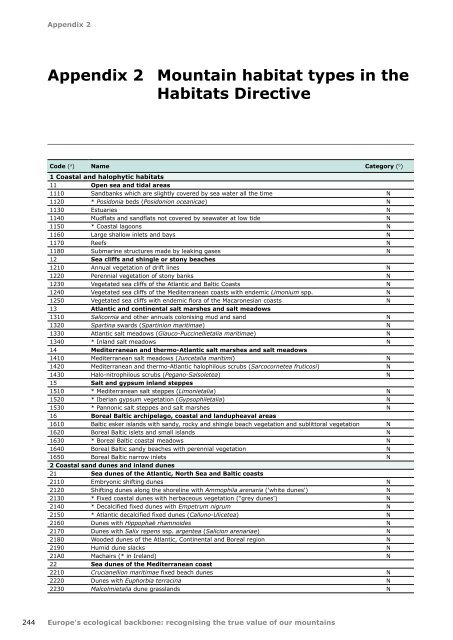Europes ecological backbone.pdf
Europes ecological backbone.pdf
Europes ecological backbone.pdf
You also want an ePaper? Increase the reach of your titles
YUMPU automatically turns print PDFs into web optimized ePapers that Google loves.
Appendix 2<br />
Appendix 2 Mountain habitat types in the<br />
Habitats Directive<br />
Code ( a ) Name Category ( b )<br />
1 Coastal and halophytic habitats<br />
11 Open sea and tidal areas<br />
1110 Sandbanks which are slightly covered by sea water all the time N<br />
1120 * Posidonia beds (Posidonion oceanicae) N<br />
1130 Estuaries N<br />
1140 Mudflats and sandflats not covered by seawater at low tide N<br />
1150 * Coastal lagoons N<br />
1160 Large shallow inlets and bays N<br />
1170 Reefs N<br />
1180 Submarine structures made by leaking gases N<br />
12 Sea cliffs and shingle or stony beaches<br />
1210 Annual vegetation of drift lines N<br />
1220 Perennial vegetation of stony banks N<br />
1230 Vegetated sea cliffs of the Atlantic and Baltic Coasts N<br />
1240 Vegetated sea cliffs of the Mediterranean coasts with endemic Limonium spp. N<br />
1250 Vegetated sea cliffs with endemic flora of the Macaronesian coasts N<br />
13 Atlantic and continental salt marshes and salt meadows<br />
1310 Salicornia and other annuals colonising mud and sand N<br />
1320 Spartina swards (Spartinion maritimae) N<br />
1330 Atlantic salt meadows (Glauco-Puccinellietalia maritimae) N<br />
1340 * Inland salt meadows N<br />
14 Mediterranean and thermo-Atlantic salt marshes and salt meadows<br />
1410 Mediterranean salt meadows (Juncetalia maritimi) N<br />
1420 Mediterranean and thermo-Atlantic halophilous scrubs (Sarcocornetea fruticosi) N<br />
1430 Halo-nitrophilous scrubs (Pegano-Salsoletea) N<br />
15 Salt and gypsum inland steppes<br />
1510 * Mediterranean salt steppes (Limonietalia) N<br />
1520 * Iberian gypsum vegetation (Gypsophiletalia) N<br />
1530 * Pannonic salt steppes and salt marshes N<br />
16 Boreal Baltic archipelago, coastal and landupheaval areas<br />
1610 Baltic esker islands with sandy, rocky and shingle beach vegetation and sublittoral vegetation N<br />
1620 Boreal Baltic islets and small islands N<br />
1630 * Boreal Baltic coastal meadows N<br />
1640 Boreal Baltic sandy beaches with perennial vegetation N<br />
1650 Boreal Baltic narrow inlets N<br />
2 Coastal sand dunes and inland dunes<br />
21 Sea dunes of the Atlantic, North Sea and Baltic coasts<br />
2110 Embryonic shifting dunes N<br />
2120 Shifting dunes along the shoreline with Ammophila arenaria ('white dunes') N<br />
2130 * Fixed coastal dunes with herbaceous vegetation (“grey dunes') N<br />
2140 * Decalcified fixed dunes with Empetrum nigrum N<br />
2150 * Atlantic decalcified fixed dunes (Calluno-Ulicetea) N<br />
2160 Dunes with Hippophaë rhamnoides N<br />
2170 Dunes with Salix repens ssp. argentea (Salicion arenariae) N<br />
2180 Wooded dunes of the Atlantic, Continental and Boreal region N<br />
2190 Humid dune slacks N<br />
21A0 Machairs (* in Ireland) N<br />
22 Sea dunes of the Mediterranean coast<br />
2210 Crucianellion maritimae fixed beach dunes N<br />
2220 Dunes with Euphorbia terracina N<br />
2230 Malcolmietalia dune grasslands N<br />
244<br />
Europe's <strong>ecological</strong> <strong>backbone</strong>: recognising the true value of our mountains

















